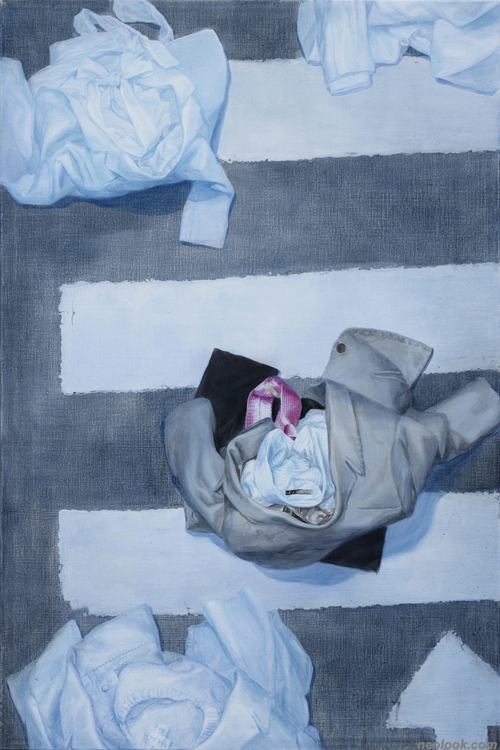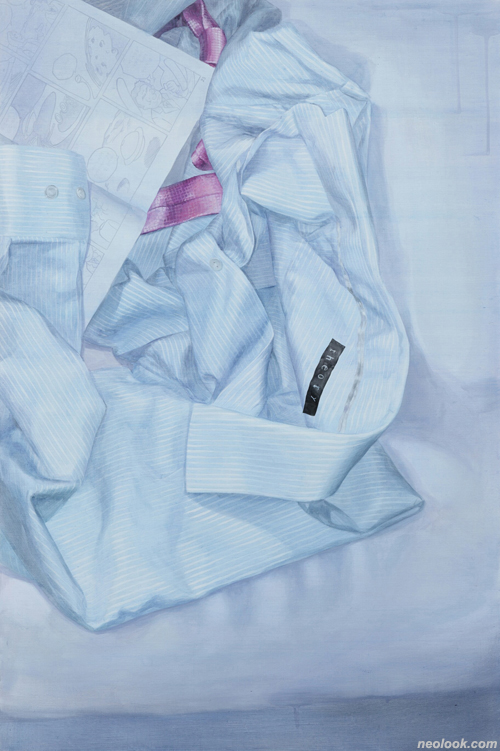- ● homepage
- ● archives
- ● restoration
- ● books
- ● big banners
- ● post board
- ■ neo's search
- ■ about us
- ■ 게재방법 안내
- 개인정보처리방침

- [email protected]
- Tel. 02_335_7922
- Fax. 02_335_7929
- 10:00am~04:30pm
- 월요일~금요일
- 3/3(월) 대체공휴일

Pinktie
이영은展 / LEEYOUNGEUN / 李泳恩 / painting 2014_0423 ▶ 2014_0429
● 위 이미지를 클릭하면 네오룩 아카이브 Vol.20121205c | 이영은展으로 갑니다.
이영은 블로그_blog.naver.com/skyoath
별도의 초대일시가 없습니다.
관람시간 / 11:00am~06:00pm / 월요일_12:00pm~06:00pm
갤러리 도스 GALLERY DOS 서울 종로구 삼청로 7길 37(팔판동 115-52번지) Tel. +82.2.737.4678 www.gallerydos.com
껍질 속 무너지는 경계 ● 옷장은 외출을 하기 전 변신의 공간이다. 이 장소를 시작점으로 사람들은 집과 직장, 외출과 귀가, 사생활과 사회생활 등 각양각색의 경계들을 넘나든다. 상황과 목적에 따라 자신의 모습을 만들어 사용하는 '외부'가 있는가 하면 '내부'에서는 완벽하게 개인적인 공간으로 돌아온 뒤에야 본래의 자기모습으로 돌아올 수 있는 때가 있다. 상반되는 두 가지 상황 전부 우리가 가진 생활의 일부분이다. 장소와 신분 같은 다양한 조건들에 맞춰 입게 되는 옷은 특정한 균일화를 불러오게 되고, 그 중 하나인 넥타이는 현대에서 볼 수 있는 대표적인 획일화의 상징물이다. 이처럼 이영은의 그림 속에서 의복의 부표가 된 일상의 물건은 작가의 시선을 대변한다.

- 이영은_crossing_캔버스에 아크릴채색, 유채_90×60cm_2014
속이 텅 빈 옷들은 일상의 여러 장면들 속에서 주인공인 사람이 부재하는 상태로 재조명을 받는다. 일거리가 쌓여있는 컴퓨터 앞에 쓰러져 잠든 모습, 만화책을 읽다 드러누운 모습, 횡단보도를 걷거나 카페에서 마주앉아 대화를 나누는 모습 등 주인 없는 옷들이 만들어내는 기이한 광경들이다. 입는 사람이 없이 널브러진 옷들은 방금 벗어둔 것처럼 사람의 자세가 흔적처럼 남겨져 있다. 이런 흔적들 덕분에 옷들만 가지고도 어떤 일이 일어나고 있는지 그 상태를 짐작해보는 것은 그리 어렵지 않은 과정이다. 이런 것이 가능한 또 다른 이유로는 옷의 종류와 그걸 입는 상황이 어떤 사회적인 카테고리 안에 담겨있는지를 관람자의 머릿속에 이미 상식이라는 이름으로 입력된 규칙으로 충분히 분류할 수 있다는 점을 들 수 있다. 작가는 작품을 통해 은연중에 이러한 점들을 지적한다. 드레스 코드라는 단어가 공공연히 존재하는 현대 사회에서 때와 장소에 따른 복장은 규정이라는 형태로 우리에게 강제성을 부여한다. 소속감은 동시에 구속감의 의미를 동반하게 되었고 넥타이 또한 부정적인 의미에서는 회사의 한 구성원으로 복종하게 만드는 목줄 정도로 인식된다. 작가는 본연의 자신을 감추고 타자의 필요에 의한 이미지를 만들어 사용하는 사람의 '외부'와 누구의 시선도 받지 않는 곳에서만 자기 스스로에게 솔직한 모습을 드러낼 수 있는 '내부'를 주관적인 자신, 그리고 객관적인 타자의 눈으로 응시한다.

- 이영은_sleeping_캔버스에 아크릴채색, 유채_90×60cm_2014
작품 속 풍경을 바라보는 시점은 카페 바로 옆 테이블에 앉아서 바라보는 것 같은, 그리고 공중에 설치된 CCTV의 렌즈를 통해 관망하듯 내려다보는 듯한 시선 등 다양한 위치에서 시작된다. 이런 외면과 내면, 그 둘의 경계선에서 공존이 가능하게 만들어주는 중개자의 의미를 작가는 의복에 두게 되면서 넥타이 시리즈 작업을 시작하게 되었다. 그러나 이영은의 작품 속에서 우리가 훔쳐보게 되는 단편적인 타인의 삶의 순간들은 자신의 삶과도 전혀 무관하지 않다는 공감의 여지를 갖고 있다. 특정한 주인공이 존재하지 않는 공간에서는 어떠한 등급과 구분도 존재하지 않으며 온라인 네트워크처럼 익명성이 만들어주는 모종의 평등함을 연상케 한다. 이는 작품 안팎의 모든 인물에게 작품의 주인공으로 포함시키는 힘을 제공한다. 타인과 자신, 내부와 외부, 작가와 관람자를 구분 짓는 경계가 작품 안에서는 불필요해지는 효과를 가져 온다.

- 이영은_breaktime_캔버스에 아크릴채색, 유채_90×60cm_2014

- 이영은_breaktime_캔버스에 아크릴채색, 유채_90×60cm_2014
소통을 위한 도구이자 동시에 자신을 감출 수 있는 방패가 되는 옷 안에는 이중적인 의미가 내포되어 있으며 만들어진 것이라는 점에서 흥미롭게 다가온다. 이영은의 작품 속에서 넥타이는 여러 장소에서의 각각의 모습으로 존재하는 외적인 모습 전부가 그 자신에게 소속된다는 것을 알려주는 신호등과 같은 역할을 한다. 작가는 익명의 옷들을 통해 우리가 생활 속에서 어떠한 소통을 만들어 왔는지를 자각하게 한다. 주인공이 없는 작품 앞에서 자신은 타인에게 어떤 형태로 비춰지기를 바라고 있는지, 또 그걸 위해 자신이 만들어낸 외면은 어떤 모습인지를 자문하게 만든다. ■ 윤채원

- 이영은_극장_캔버스에 아크릴채색, 유채_112×486cm_2014

- 이영은_극장_캔버스에 아크릴채색, 유채_112×162cm_2014
Breaking down boundaries within skin ● A closet is a space of change before going out. It's a starting point for people to cross all kinds of boundaries between home and work, out and at home, public and private life. If we say there is an 'outside' for which people create an appearance to suit their situation and goal, then 'inside' must be a place of perfect privacy where people return to their essential appearance. These two opposites are part of our total lives. The clothes we wear to suit the varying conditions of place or identity are part of a balance, and the necktie is a part of that, a representative symbol of the uniformity you see in the modern world. In this way, this everyday object is a sign within Lee Yeong-eun's picture and speaks for the author. ● Empty clothes are highlighted to show the absence of their owner in various scenes. With the appearance of sleeping in front of a computer at work, lying down reading a comic book, crossing a crosswalk or sitting and talking in a cafe, the clothes here make for odd scenes without their owner. The clothes look as if they'd just been removed and traces of their owner still remain. Thanks to these clothes, it's not difficult to guess what had been happening in each situation. Another reason it's easy to guess is that the observer can also imagine the situation just from seeing the type of clothing and knowing what kind of social category it fits into as these can be sufficiently classified socially based on rules. The creator implies these points through his work. In a modern society where the term 'dress code' is openly used, clothes give us a sense of compulsion as our attire changes based on time and place. They mean a sense of belonging and of imprisonment at the same time. A necktie is recognized negatively as a rope around the neck of a worker at a company. The artist uses the concepts of a person's 'outside', an image created according to need to hide one's true essence, and 'inside', the true appearance that is only shown when no one else is watching, to examine the subjective self and objective others. Looking at the scenes in the work is like sitting at the next table in a cafe or like observing through a CCTV lens in different locations. The author began this necktie series with two outfits acting as intermediaries defining a boundary so the outside and inside can coexist. But within Lee Yeong-eun's work, the moments in which we get brief glimpses into the life of another provoke doubt as to whether our own lives are completely unrelated. In spaces where a particular protagonist doesn't exist, such at the Internet, there are no grades or classifications and a certain equality is created through anonymity. Everyone is included, on both the inside and out, as the protagonists of this work. There is no need within this work to create boundaries between myself and others, inside and outside, the artist and the spectator. ● Within clothes, with their implied double meaning as a tool for communication while simultaneously being a shield to hide ourselves, we have a point to approach with interest. The necktie in Lee Yeong-eun's work plays a role similar to that of a traffic light, letting us know a person's affiliation through each overall external appearance in various locations. The author lets us know what kind of communication is created within our lives through the clothes of some anonymous person. This work makes the person in front of it question what appearance they've created for their exterior in order to highlight the form he shows to others. ■ YUNCHAEWON
Vol.20140423d | 이영은展 / LEEYOUNGEUN / 李泳恩 / painting

